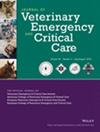Abdominal fluid score as a predictor of transfusion needs and outcome in cats following trauma
Abstract
Objective
To assess the value of the abdominal fluid score (AFS) in cats following trauma in determining surgical needs, transfusion needs, and mortality.
Design
Multicenter retrospective observational study utilizing data from the Veterinary Committee on Trauma (VetCOT) registry.
Setting
VetCOT Veterinary Trauma Centers.
Animals
A total of 2309 cats entered into the VetCOT registry between January 1, 2013, and December 31, 2020, were included.
Interventions
None.
Measurements and Main Results
Of the included cats, 148 had abdominal effusion on presentation (AFS 1–4, positive AFS [pAFS]). pAFS cats demonstrated a lower total plasma protein (6.2 g/dL, range: 2.8–9.2 g/dL vs 6.8 g/dL, range: 2.6–11 g/dL, P < 0.001) and a more negative base excess (BE) (−9, range: −23.7 to 10 vs −6.1, range: −31.7 to 1, P = 0.001) than cats without abdominal effusion (negative AFS [nAFS]). pAFS cats also had a higher baseline Animal Trauma Triage score (ATTS) than nAFS cats (5, range 0–12 vs 3, range 0–17, respectively, P < 0.001). pAFS cats were more likely to require blood transfusions (16% [23/148] vs 4% [94/2161], P < 0.001) than nAFS cats, but need for surgical intervention did not differ between groups. A pAFS was associated with increased need for hospitalization (62.8% [93/148] vs 47.7% [1030/2160], P < 0.001), but length of hospital stay did not differ. Cats with pAFS experienced higher mortality compared to nAFS cats (42.6% [63/148] vs 22.7% [491/2161], P < 0.001).
Conclusion
The presence of abdominal effusion in cats following trauma was associated with increased morbidity in this study, as demonstrated by greater need for transfusion, increased likelihood of hospitalization, and greater mortality. Cats in the pAFS group had more negative BE and higher ATTS, but need for surgery, length of hospitalization, PCV, and blood glucose, plasma lactate, and ionized calcium concentrations were not different between groups.

 求助内容:
求助内容: 应助结果提醒方式:
应助结果提醒方式:


